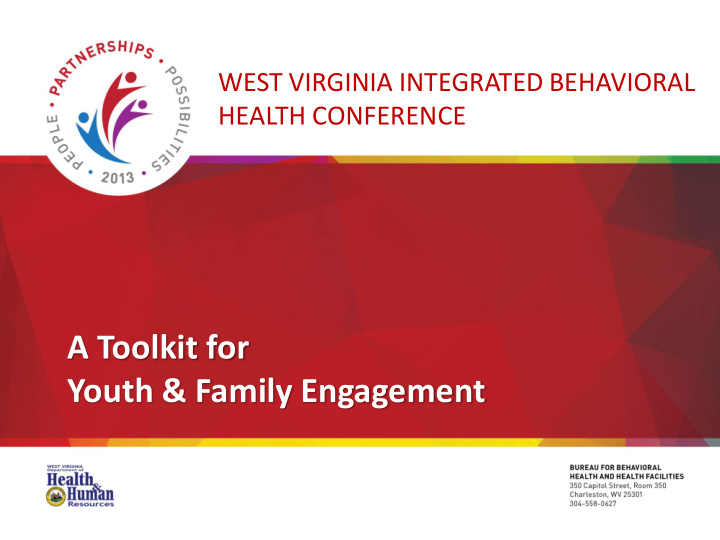



WEST VIRGINIA INTEGRATED BEHAVIORAL HEALTH CONFERENCE A Toolkit for Youth & Family Engagement
Working together to better serve West Virginia children, youth & families • Statewide Family & Youth Voice • Clinical Review for Youth in Out-of- Home Care • Assistance & Recommendations to build values into practice • Professional Development “Learning Ladder” includes: Family Centered Practice Basics Trauma-Informed Care Cultural & Linguistic Competence Family-Youth Engagement Strategies 2
3
Learning Objectives 1. Define Family-Youth Engagement 2. Benefits & Challenges of Engagement 3. Six Components of WV Family-Youth Engagement 4. Toolkits to support top engagement strategies 4
Stages of Change Pre-Contemplation “Haven’t Thought About It” Contemplation “Thinking About It” Maintenance Determination - “Part of Everyday Preparation Life” “Getting Ready” Action “Doing It” 5
WV Child Serving Systems SYSTEM PURPOSE OF LAW BEHIND SYSTEM HOW MIGHT (Agency) PARENTS VIEW IT? • Safety CHILD WELFARE • Permanency (WV-DHHR Bureau for Children & Families) • Well-Being of WV children and youth Access to quality services and supports for children and MENTAL HEALTH adolescents with, or at risk for, behavioral/emotional (Comprehensive Behavioral Health Centers) disturbances Full educational opportunity SPECIAL EDUCATION to all students with disabilities (State & County Boards of Education) Appropriately meet the needs of every youth placed in JUVENILE JUSTICE the custody of Juvenile Services (WV Division of Juvenile Services Programs & Treatment Dept.) 6
West Virginia Definition of Family Engagement • Deliberate • Strengths-Based • Continuous • Two-Way • Honest & Open (WVSOC Family Engagement Curriculum Task Team, May 2012) 7
West Virginia’s Six Elements of Family Engagement 1. A welcoming environment 2. Focus on strengths and self-empowerment 3. Focus on results 4. Respect for individual experiences, views and cultures 5. Network building 6. Sustained engagement 8
“You never get a second chance to make a first impression.” 1. WELCOMING ENVIRONMENT 9
What this element looks like to families: • Not feeling “judged” when entering • Directional signs • Adequate waiting areas with open, comfortable seats • Smiling faces • Positive telephone contacts • Clean environments - soothing colors • Developmentally appropriate areas for children with adequate toys & materials 10
“We do not have to become heroes overnight. Just a step at a time, meeting each thing that comes up ... discovering we have the strength to stare it down.” ELEANOR ROOSEVELT 2. FOCUS ON STRENGTHS AND SELF-EMPOWERMENT 11
What this element looks like to families: • Parents viewed as capable • Working with parents as partners and leaders • “Do not streamline process” • Making decisions with family input • “Get to know my family better” • Eliminate intimidating meetings in which parents are outnumbered • Offer parental training or other resources 12
“Off the rack solutions, like bargain basement dresses, never fit anyone.” FRANCOISE GIROUD 3. FOCUS ON RESULTS 13
What this element looks like to families • Setting clear outcomes • Monitor and keep parents updated of progress • Clear expectations • Ongoing assessment 14
4. Respect for Individual Experiences, Views & Cultures • Use person first language • Use “layman’s” terms • Avoid acronyms • Consider religious preferences • Allow opportunities for feedback, such as surveys • Treat parents with dignity and respect 15
Organizational Culture: “Swim in the Alphabet Soup” 16
Small but Powerful: Micro-messages • Examples : – Weak handshake – Little or no eye contact – Arms crossed across chest – Praising an idea presented by one; ignoring the same idea presented by another – Pecking away at cell phone/other device while someone is talking – Looking at watch while someone is talking • Negative Micro-Messages (or Micro-inequities) – Increase intimidation & shut down engagement 17
5. Network Building • Opportunity to develop supportive relationships • Offer parent mentoring • Participate in community activities • Broaden support groups to more individuals 18
6. Sustained Engagement • Open communication and interaction • Increased parent participation opportunities • Grow parent interest and skills 19
West Virginia Service Providers “Top 12 Do -able Strategies ” 1. A welcoming environment 2. Focus on strengths and self-empowerment 3. Focus on results 4. Respect for individual experiences, views and cultures 5. Network building 6. Sustained engagement 20
What It Means to Families: • Full Involvement making decisions & setting goals • Service providers will understand what family & youth or child do well, and what they need • Families & Youth will better understand resources and tools available to help • Families, youth & children will achieve goals we all share 21
Questions? Visit www.wvsystemofcare.org for training dates, toolkits & information 22
Recommend
More recommend